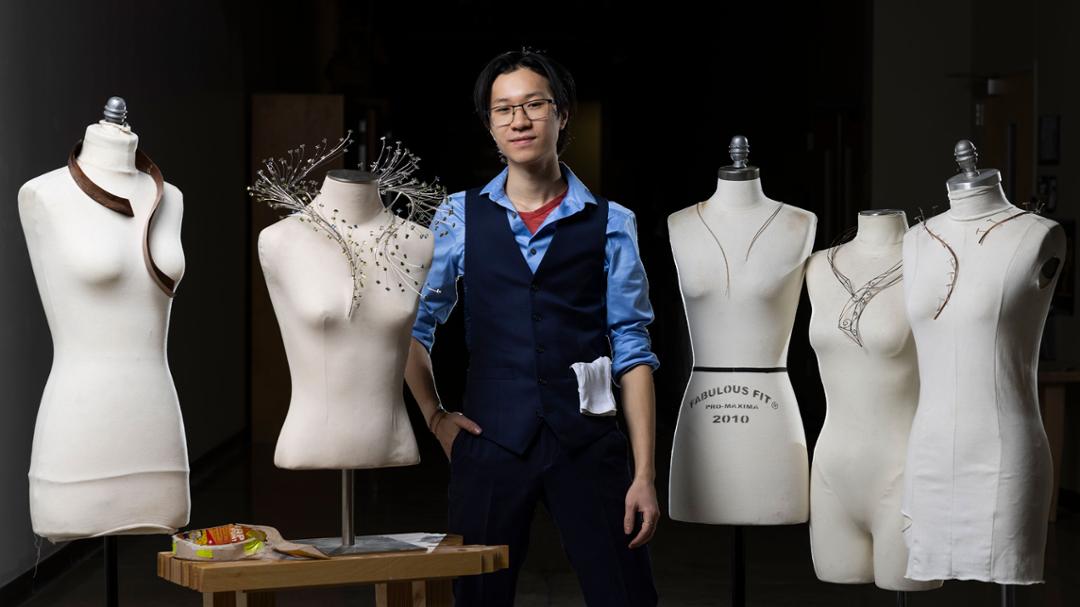The Texas-based jeweler presented the historic gift to the jewelry and metalsmithing program.
There are plenty of programs and facilities that draw students to Texas Tech University.
One of these is tucked into the north side of campus, nestled behind trees and recognizable by sculptures and outdoor kilns. It’s the School of Art’s 3D Annex, which houses jewelry, ceramic and sculpture programs.
For jewelry makers, the annex boasts a state-of-the-art space that’s the thing of dreams. One of the finest facilities in the Southwest, students from around the country are drawn to Texas Tech because of the studio and faculty.
In 2023, the jewelry design and metalsmithing program received a gift from James Avery Artisan Jewelry that made its already appealing program shine even brighter.
The well-known jewelers headquartered in Texas presented Texas Tech with a historic gift of more than 30,000 precious stones and gems. Students’ eyes grew wide as they took in the beauty of each unique and brilliant stone.
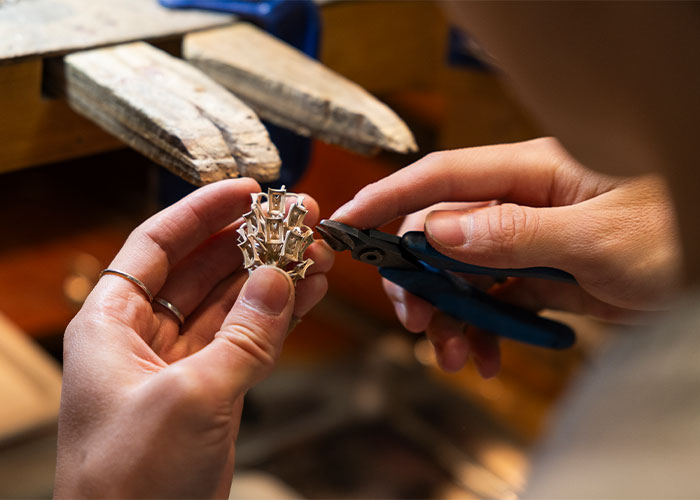
One of those students was Christopher Liu, a fourth-year with a genius for taking seemingly unconnected materials and turning them into something beautiful.
Guidance and Grit
Robly Glover, professor of jewelry design and metalsmithing, remembers the first time he met Liu. Liu was visiting campus with his high school jewelry teacher, John Garrett, a Texas Tech alumnus.
“Most students do not come in with as much experience as Chris did,” Glover said.
Because Liu was being mentored by an alumnus of the program, he had a competitive advantage.
“I’m realistic about guiding talent that already exists,” Glover said. “I can’t make a student smart, and I can’t make a student figure out something they don’t want to figure out. I’m here as a guide.”
Liu has flourished under Glover’s guidance, not needing much handholding.
The young jewelry maker knew since he was 12 years old that he liked crafting with his hands.
“I helped my father craft an arbor for our yard,” Liu said. “We grew grapes and even made wine that year.”
Liu and his siblings also ventured into woodworking. They made their own bow and arrows among other items. Liu remembers the feeling of pride he had when his father entrusted him with equipment at a young age.
Liu’s love of tinkering led him to believe he’d like to study architecture or engineering. In high school, he looked at programs where he could study architectural design or structural engineering.
Then he met John Garrett.
Garrett had built an incredibly rare jewelry program at Allen High School in Liu’s native Dallas-Fort Worth. Garrett’s jewelry and metals class was an elective that changed Liu’s trajectory.
“I got so much hands-on experience in Mr. Garrett’s program,” Liu said. “I found it was something I could take control of, and I could make the materials into anything I wanted. I found my passion.”
When Garrett brought Liu to visit Texas Tech, Liu knew he had found his next step.
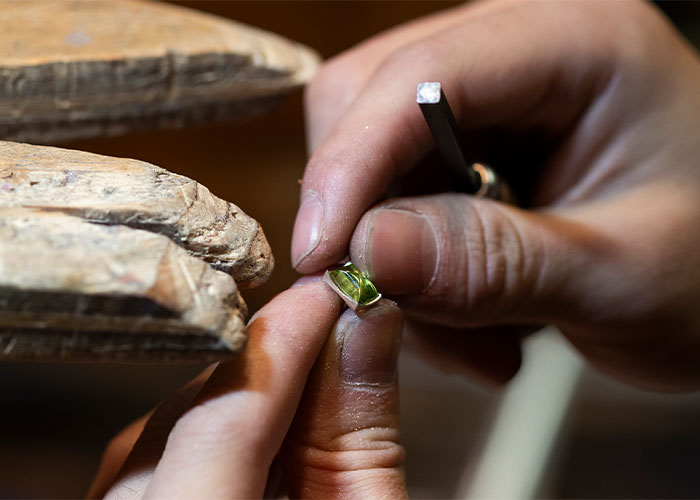
Liu says the facility was the best he visited. Undergraduates have their own workstations, a rarity usually reserved for graduate students. Most undergrad programs have students sharing space on a rotating basis, but that also means rotating materials which takes a lot of time.
Beyond the resources available to Liu, he was immediately impressed with Glover and the care he took in listening to Liu’s dreams and ambitions.
“I was sold,” Liu recalled. “Working with Glover is like standing on the shoulders of one of the giants in the industry. Having his support has made all the difference.”
Glover has worked at Texas Tech for more than 20 years. He built up and developed the jewelry program into one of the most competitive in the nation. Glover recalls the past few decades and acknowledges it’s been a trying time for academic jewelry programs.
“As other programs were losing space and funding, we just kept gaining students and building our program,” Glover said.
He credits the success to a supportive faculty and administration, and a university that values the arts.
A Historic Gift
In early 2023, Glover received news that would take the jewelry program to a new level.
“James Avery announced they were going to gift Texas Tech with roughly 30,000 precious and semi-precious stones,” Glover said.
Many alumni of the program have gone on to work at James Avery, creating a strong tie between the renowned company and the esteemed academic program. The gift didn’t come randomly, but rather, was the outcome of a carefully nurtured relationship invested in over the years.
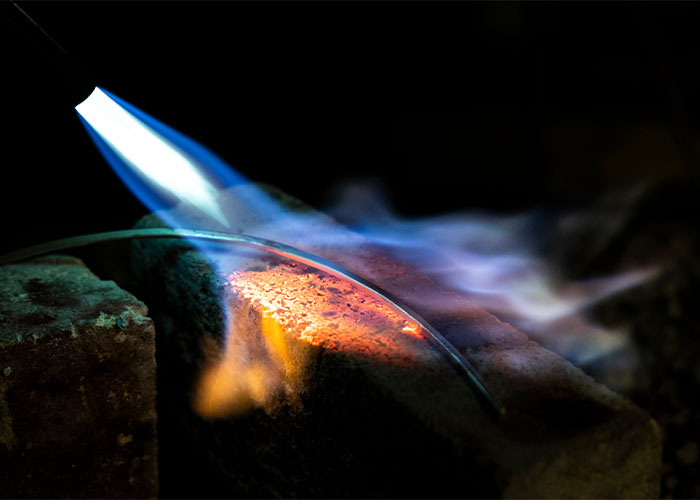
James Avery has had Texas Tech students visit its headquarters in Kerrville, Texas, multiple times. The tours have offered students insight into what it’s like to work for a major jeweler.
The generosity both James Avery and Texas Tech have shown each other is special, but quite unusual for the industry.
“In jewelry, you have two worlds: the commercial world and the art world,” Glover said. “Historically, there has been animosity between these two simply because I think they don’t understand each other. They’ve mistreated each other and that’s unfortunate.”
Commercial jewelers fail to see the value artists’ new ideas bring to the industry, perceiving art jewelers as pretentious. And art jewelers devalue the necessary and meaningful work of commercial jewelers.
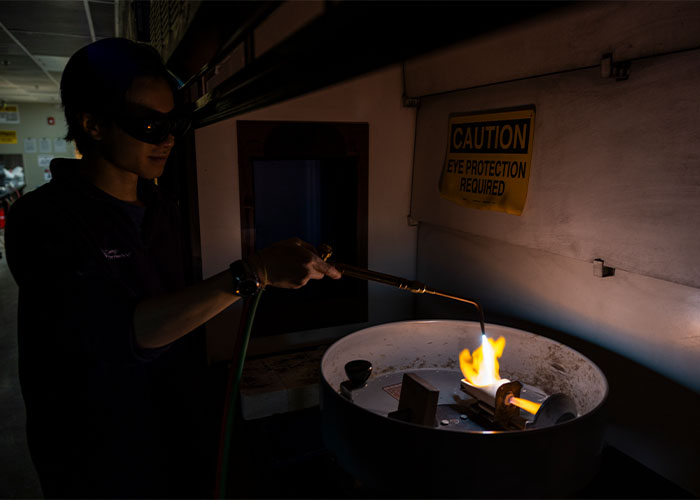
“One of the things unique about our program is that we respect both the commercial and the art worlds and prepare students who go into both,” Glover said.
Glover has work featured in various museums around the U.S. but also has enthusiastically done commercial work he is proud of.
“The two worlds are different, but equally important,” he said.
It is that very sentiment that opened the door for an incredible act of generosity from James Avery. Glover remembers the day the stones were brought into class for the students to see.
“They were like kids in a candy store,” he laughed.
The extraordinary inventory includes various kinds of pearls, amethyst, topaz, turquoise and many other gems. The color palette is incredible, each piece catching the eye in a new way.
“Just looking at the stones gave the students new inspiration,” Glover said.
When Glover announced the news, Liu was in disbelief.
Then, when the disbelief wore off, he jumped into action. He wanted to hit the ground running once the stones arrived. He examined the materials he was working with, determining what might pair nicely with the James Avery stones and what he wanted to set aside.
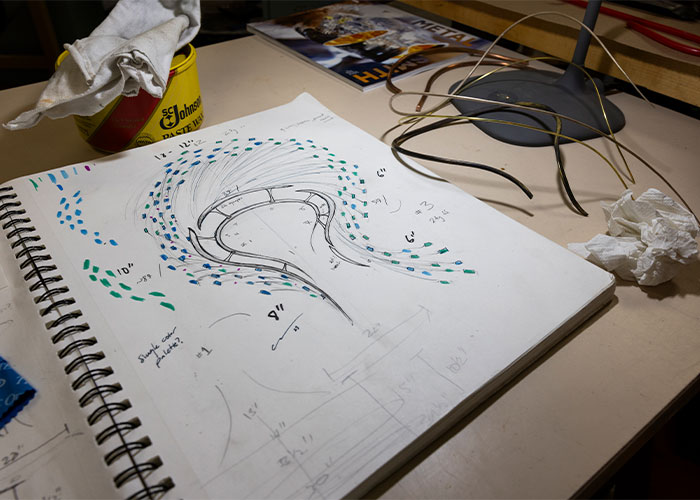
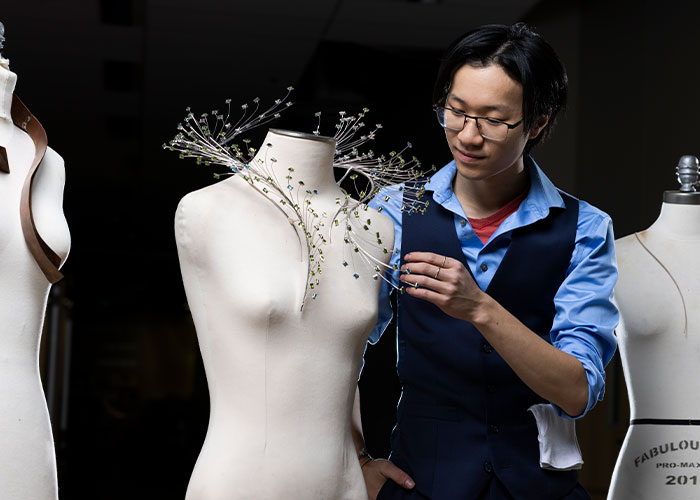
“These stones have given me such a competitive edge,” Liu beams. “Not many universities have this kind of access and resources. Now I don’t have to worry about the financial burden procuring materials.”
Liu capitalized on that competitive edge.
His work with the James Avery inventory helped him win a scholarship through the Manufacturing Jewelers and Suppliers of America (MJSA). The group’s education foundation named three recipients in 2023.
Liu was one of them.
“This scholarship will help me continue my work,” Liu said.
One of his favorite works he’s done with the James Avery stones is a necklace that lifts off the body, almost mimicking an Elizabethan collar but adorned with metal and amethyst.
And while some may see jewelry as mere trinkets, it is an art form that stands equal with other mediums – perhaps, even more so.
“When someone loves a painting, they buy it and put it on their wall,” Glover said. “But when someone loves a piece of jewelry, they put it on their body. It’s personal.”
Whether it marks a birth, a sweet 16, an engagement, a graduation, a deployment or an anniversary, everyone has pieces of jewelry that are precious.
“That’s what makes jewelry so special,” Glover said. “You can’t wear your painting out. But with jewelry, it’s interacting with the body. It becomes part of conversation, part of your life. When you’re in a heated argument and shaking your head, your earrings swing. When you hold your head high with pride, your necklace sprawls.”
Jewelry is not purely about status or luxury.
And the partnership between Texas Tech and James Avery highlights that truth.
“I can’t think of any other company who has done something like this for us,” Glover said. “We’re so incredibly grateful.”

